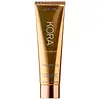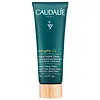What's inside
What's inside
 Key Ingredients
Key Ingredients

 Benefits
Benefits

 Concerns
Concerns

 Ingredients Side-by-side
Ingredients Side-by-side

Aloe Barbadensis Leaf Juice
Skin ConditioningPumice
AbrasiveGlycerin
HumectantRosa Canina Seed Powder
AbrasiveLactobacillus Ferment
Skin ConditioningWater
Skin ConditioningCamellia Sinensis Leaf Powder
ExfoliatingBambusa Arundinacea Stem Extract
Skin ConditioningOryza Sativa Extract
AbsorbentMorinda Citrifolia Seed Powder
Skin ConditioningLactobacillus
Skin ConditioningRosa Canina Fruit Oil
EmollientSodium Levulinate
Skin ConditioningSclerotium Gum
Emulsion StabilisingPopulus Tremuloides Bark Extract
AntiseborrhoeicCarica Papaya Fruit Extract
Skin ConditioningCetearyl Alcohol
EmollientSodium Anisate
AntimicrobialPotassium Sorbate
PreservativeCurcuma Longa Root Extract
MaskingCocos Nucifera Fruit Extract
EmollientSodium Stearoyl Glutamate
CleansingHelianthus Annuus Seed Wax
Skin ConditioningMentha Piperita Flower/Leaf/Stem Oil
Skin ConditioningLactic Acid
BufferingLavandula Angustifolia Oil
MaskingCitrus Limon Peel Oil
MaskingMaltodextrin
AbsorbentCetearyl Glucoside
EmulsifyingCarrageenan
Sodium Phytate
Cananga Odorata Flower Oil
MaskingJuniperus Virginiana Oil
MaskingGlucose
HumectantLeuconostoc Ferment Filtrate
AntimicrobialTocopherol
AntioxidantSoybean Peroxidase
AntioxidantSuperoxide Dismutase
AntioxidantAscorbyl Palmitate
AntioxidantAlcohol
AntimicrobialLimonene
PerfumingLinalool
PerfumingAloe Barbadensis Leaf Juice, Pumice, Glycerin, Rosa Canina Seed Powder, Lactobacillus Ferment, Water, Camellia Sinensis Leaf Powder, Bambusa Arundinacea Stem Extract, Oryza Sativa Extract, Morinda Citrifolia Seed Powder, Lactobacillus, Rosa Canina Fruit Oil, Sodium Levulinate, Sclerotium Gum, Populus Tremuloides Bark Extract, Carica Papaya Fruit Extract, Cetearyl Alcohol, Sodium Anisate, Potassium Sorbate, Curcuma Longa Root Extract, Cocos Nucifera Fruit Extract, Sodium Stearoyl Glutamate, Helianthus Annuus Seed Wax, Mentha Piperita Flower/Leaf/Stem Oil, Lactic Acid, Lavandula Angustifolia Oil, Citrus Limon Peel Oil, Maltodextrin, Cetearyl Glucoside, Carrageenan, Sodium Phytate, Cananga Odorata Flower Oil, Juniperus Virginiana Oil, Glucose, Leuconostoc Ferment Filtrate, Tocopherol, Soybean Peroxidase, Superoxide Dismutase, Ascorbyl Palmitate, Alcohol, Limonene, Linalool
Water
Skin ConditioningKaolin
AbrasiveBentonite
AbsorbentGlycerin
HumectantAcacia Senegal Gum
MaskingXanthan Gum
EmulsifyingBenzyl Alcohol
PerfumingAlcohol
AntimicrobialSodium Dehydroacetate
PreservativeCI 77491
Cosmetic ColorantCitrus Aurantium Bergamia Fruit Oil
MaskingVitis Vinifera Fruit Extract
Skin ConditioningLimonene
PerfumingLavandula Angustifolia Oil
MaskingLinalool
PerfumingSodium Citrate
BufferingCitric Acid
BufferingDehydroacetic Acid
PreservativeCoffea Arabica Seed Extract
MaskingCoffea Robusta Seed Extract
Skin ConditioningCarbomer
Emulsion StabilisingCupressus Sempervirens Oil
MaskingSalvia Sclarea Oil
MaskingCI 77499
Cosmetic ColorantCommiphora Myrrha Oil
MaskingSantalum Album Oil
MaskingAnthemis Nobilis Flower Oil
MaskingPapain
Skin ConditioningPetroselinum Crispum Seed Oil
Masking1,2-Hexanediol
Skin ConditioningCaprylyl Glycol
EmollientSodium Benzoate
MaskingLactic Acid
BufferingAlgin
MaskingPotassium Sorbate
PreservativeWater, Kaolin, Bentonite, Glycerin, Acacia Senegal Gum, Xanthan Gum, Benzyl Alcohol, Alcohol, Sodium Dehydroacetate, CI 77491, Citrus Aurantium Bergamia Fruit Oil, Vitis Vinifera Fruit Extract, Limonene, Lavandula Angustifolia Oil, Linalool, Sodium Citrate, Citric Acid, Dehydroacetic Acid, Coffea Arabica Seed Extract, Coffea Robusta Seed Extract, Carbomer, Cupressus Sempervirens Oil, Salvia Sclarea Oil, CI 77499, Commiphora Myrrha Oil, Santalum Album Oil, Anthemis Nobilis Flower Oil, Papain, Petroselinum Crispum Seed Oil, 1,2-Hexanediol, Caprylyl Glycol, Sodium Benzoate, Lactic Acid, Algin, Potassium Sorbate
 Reviews
Reviews

Ingredients Explained
These ingredients are found in both products.
Ingredients higher up in an ingredient list are typically present in a larger amount.
Alcohol comes in many different forms. Different types of alcohol will have different effects on skin. This ingredient is usually an astringent alcohol.
These alcohols are drying on the skin. They may strip away your skin's natural oils and even damage your skin barrier. Astringent alcohols may also irritate skin.
Other types of astringent alcohols include:
According to the National Rosacea Society based in the US, you should be mindful of products with these alcohols in the top half of ingredients.
Any type of sanitizing product will have high amounts of alcohol to help kill bacteria and viruses.
Fatty alcohols come from plant oils such as coconut oil. These can help hydrate the skin and are non-irritating. Some fatty alcohols include cetyl and stearyl alcohol.
Learn more about AlcoholGlycerin is already naturally found in your skin. It helps moisturize and protect your skin.
A study from 2016 found glycerin to be more effective as a humectant than AHAs and hyaluronic acid.
As a humectant, it helps the skin stay hydrated by pulling moisture to your skin. The low molecular weight of glycerin allows it to pull moisture into the deeper layers of your skin.
Hydrated skin improves your skin barrier; Your skin barrier helps protect against irritants and bacteria.
Glycerin has also been found to have antimicrobial and antiviral properties. Due to these properties, glycerin is often used in wound and burn treatments.
In cosmetics, glycerin is usually derived from plants such as soybean or palm. However, it can also be sourced from animals, such as tallow or animal fat.
This ingredient is organic, colorless, odorless, and non-toxic.
Glycerin is the name for this ingredient in American English. British English uses Glycerol/Glycerine.
Learn more about GlycerinLactic Acid is another well-loved alpha hydroxy acid (AHA). It is gentler than glycolic acid but still highly effective.
Its main role is to exfoliate the surface of the skin by loosening the “glue” that holds dead skin cells together. Shedding those old cells leads to smoother, softer, and more even-toned skin.
Because lactic acid molecules are larger than glycolic acid, they don’t penetrate as deeply. This means they’re less likely to sting or irritate, making it a great choice for beginners or those with sensitive skin.
Like glycolic acid, it can:
Lactic acid also acts as a humectant (like hyaluronic acid). It can draw water into the skin to improve hydration and also plays a role in the skin's natural moisturizing factor (NMF) in the form of sodium lactate.
Studies show it can boost ceramide production to strengthen the skin barrier and even help balance the skin’s microbiome.
To get results, choose products with a pH between 3-4.
Lower strengths (5-12%) focus on surface exfoliation; higher strengths (12% and up) can reach deeper in the dermis (deeper, supportive layer) to improve skin texture and firmness over time.
Though it was originally derived from milk, most modern lactic acid used in skincare is vegan. It is made through non-dairy fermentation to create a bio-identical and stable form suitable for all formulations.
When lactic acid shows up near the end of an ingredient list, it usually means the brand added just a tiny amount to adjust the product’s pH.
Legend has it that Cleopatra used to bathe in sour milk to help reduce wrinkles.
Lactic acid is truly a gentle multitasker: it exfoliates, hydrates, strengthens, and brightens. It's a great ingredient for giving your skin a smooth, glowing, and healthy look without the harshness of stronger acids.
Read more about some other popular AHA's here:
Learn more about Lactic AcidLavandula Angustifolia Oil is more commonly known as lavender essential oil. It is considered a fragrancing ingredient.
Lavender imparts a famous scent. While the smell is lovely, this ingredient and may sensitize skin in topical products. This is because about 85% of the oil is made up of linalool and linalyl acetate.
When exposed to air, these two compounds become strong allergens. This ingredient exhibits cytotoxicity at low concentrations; amounts of 0.25% have been shown to damage skin cells.
A study from Japan found this ingredient caused lavender sensitivity after widespread exposure.
Lavender essential oil has some antimicrobial, antibacterial, and anti-inflammatory properties. However, the cons of this ingredient may outweight the pros.
More research is needed to confirm lavender essential oil's effects when used in aromatherapy.
Lavandula Angustifolia is known as the English Lavender and famous for creating purple fields in Provence, France.
Learn more about Lavandula Angustifolia OilLimonene is a fragrance that adds scent and taste to a formulation.
It's found in the peel oil of citrus fruits and other plants such as lavender and eucalyptus. The scent of limonene is generally described as "sweet citrus".
Limonene acts as an antioxidant, meaning it helps neutralize free radicals.
When exposed to air, oxidized limonene may sensitize the skin. Because of this, limonene is often avoided by people with sensitive skin.
The term 'fragrance' is not regulated in many countries. In many cases, it is up to the brand to define this term. For instance, many brands choose to label themselves as "fragrance-free" because they are not using synthetic fragrances. However, their products may still contain ingredients such as essential oils that are considered a fragrance.
Learn more about LimoneneLinalool is a fragrance and helps add scent to products. It's derived from common plants such as cinnamon, mint, citrus, and lavender.
Like Limonene, this ingredient oxidizes when exposed to air. Oxidized linalool can cause allergies and skin sensitivity.
This ingredient has a scent that is floral, spicy tropical, and citrus-like.
Learn more about LinaloolPotassium Sorbate is a preservative used to prevent yeast and mold in products. It is commonly found in both cosmetic and food products.
This ingredient comes from potassium salt derived from sorbic acid. Sorbic acid is a natural antibiotic and effective against fungus.
Both potassium sorbate and sorbic acid can be found in baked goods, cheeses, dried meats, dried fruit, ice cream, pickles, wine, yogurt, and more.
You'll often find this ingredient used with other preservatives.
Learn more about Potassium SorbateWater. It's the most common cosmetic ingredient of all. You'll usually see it at the top of ingredient lists, meaning that it makes up the largest part of the product.
So why is it so popular? Water most often acts as a solvent - this means that it helps dissolve other ingredients into the formulation.
You'll also recognize water as that liquid we all need to stay alive. If you see this, drink a glass of water. Stay hydrated!
Learn more about Water